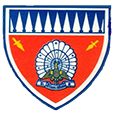The history of the Sri Lanka Army dates back to 1881. A Volunteer organization that was formed as the Citizens Rifle Association was re-designated as the Ceylon [Vol] Infantry Regiment by a Gazette notification on 01st April 1881.
Lieut. Colonel John Scott Armitage was appointed as the first Commanding Officer of this fledgling Volunteer Unit. Later, in order to encourage the concept of Volunteering, the Volunteer Force was expanded to include Units at District level. Accordingly, two Volunteer Detachments were set up in Galle and Matara in the old Dutch Forts.
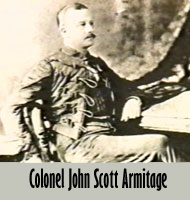 By the year 1910, the Army had expanded to include Regiments of the Ceylon Infantry, Ceylon Artillery, Ceylon Mounted Rifles, Ceylon Planters Rifles, Ceylon Service Corps and the Ceylon Medical Corps.
Thereafter, the Ceylon Defence Force was established under Army Order No: 08 of 1910, to cater to the administration and discipline of these regiments, and came under the direct purview of the Commandant, Ceylon Defence Force.
During the first World War (1914 to 1918), the Ceylon Defence Force was engaged in active service and the troops deployed in Galle and Matara too were mobilized.
By the year 1910, the Army had expanded to include Regiments of the Ceylon Infantry, Ceylon Artillery, Ceylon Mounted Rifles, Ceylon Planters Rifles, Ceylon Service Corps and the Ceylon Medical Corps.
Thereafter, the Ceylon Defence Force was established under Army Order No: 08 of 1910, to cater to the administration and discipline of these regiments, and came under the direct purview of the Commandant, Ceylon Defence Force.
During the first World War (1914 to 1918), the Ceylon Defence Force was engaged in active service and the troops deployed in Galle and Matara too were mobilized.
The Ceylon Defence Force [CDF] saw action once again during World War II [1939 to 1945]. After the War, the CDF was systematically “Ceylonised” by the appointment of Ceylonese Officers as Commanding Officers of Battalions.
After Ceylon regained Independence in 1948 the CDF was re-designated as The Ceylon Volunteer Force and the first Ceylon [Vol] Light Infantry Battalion was established.
The Detachments in Galle and Matara were re-named as “B” Company of the Ceylon [Volunteer] Light Infantry.
With the adoption of the Army Act passed in Parliament on 10th October 1949, The Ceylon Army was formed through a special Gazette notification.
The Politico-Military hierarchy decided to form Regular Infantry Battalions and the Volunteer Force was mobilized during national emergencies. With the abrogation of the Defence Pact with Great Britain, British troops were gradually phased out.
The first Regular Infantry Battalion, the 1st Battalion of the Ceylon Light Infantry came into existence on 12th May 1950. The Ceylon [Volunteer] Light Infantry was re-named as the 2nd [Volunteer] Battalion of the Light Infantry on the same day.
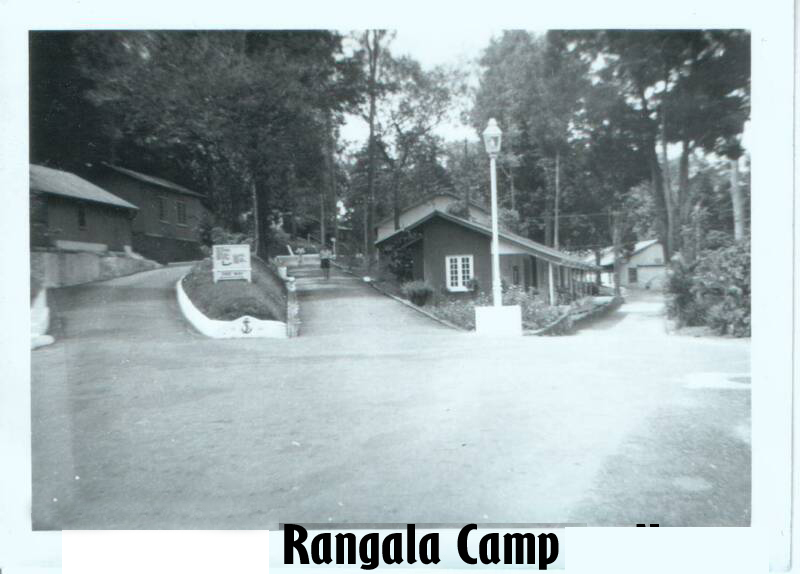 “B” Company in Galle and Matara was re-named as the Ruhuna Volunteer Regiment in 1950. The first Commanding Officer was the late Colonel C.A. Dharmapala.
“B” Company in Galle and Matara was re-named as the Ruhuna Volunteer Regiment in 1950. The first Commanding Officer was the late Colonel C.A. Dharmapala.
In 1956, with the change in the national political leadership to the Sri Lanka Freedom Party, the Ruhuna Regiment did not find favour with the political hierarchy and was disbanded. Subsequently, in October 1956, the second Regular Infantry Battalion, the 1st Battalion of the Sinha Regiment was established in the Imperial Camp in Diyatalawa.
Thereafter, the 2nd [Volunteer] Battalion of the Sinha Regiment was raised in Kandy. When the Ruhuna Regiment was disbanded, the troops located in Galle and Matara were attached to various Units. Subsequently, the troops that were deployed in Galle formed the “C” Company of the 2nd [Vol] Battalion of the Sinha Regiment.
In the latter half of 1959, 110 soldiers deployed as “C” Company of the 2nd [Vol] Battalion, Sinha Regiment under the command of Capt. D.S. Amarasuriya were brought together to form a new Volunteer Unit called the Gemunu Regiment, which was raised in Galle on 23rd November 1959. Capt. D.S. Amarasuriya was appointed the Commanding Officer.
The new Unit did not have a flag or cap badge, therefore, it was originally proposed to have the image of a Leopard associated with the Yala Sanctuary with cross rifles designed for the cap badge. However, it was not adopted. As the Permanent Staff of the Unit was drawn from the Sinha Regiment,
they followed the traditions associated with the Sinha Regiment. The third Regular Infantry Regiment, the 1st Battalion of the Gemunu Watch, was raised at the Ceylon Volunteer Force [CVF] Camp in Diyatalawa on 7th December 1962 and subsequently occupied the Rangala Camp of the Ceylon Navy and the Imperial Camp vacated by the Sinha Regiment (which had been moved to Colombo).
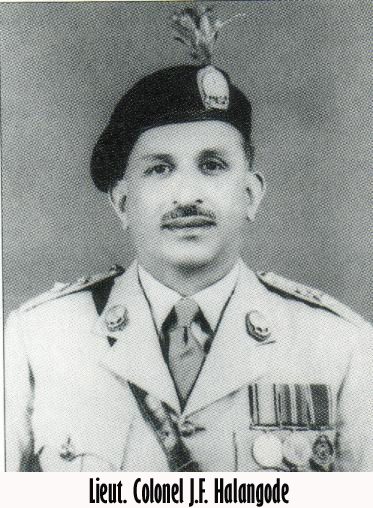 As Gemunu originated in Ruhuna, the Volunteer Gemunu Regiment established in Galle and the Detachment located in Matara were re-named Gemunu Battalions, and formed the Volunteer counterparts of the 1st Battalion of the Gemunu Watch.
The Founding Father and first Commanding Officer of the 1st Battalion of the Gemunu Watch,
As Gemunu originated in Ruhuna, the Volunteer Gemunu Regiment established in Galle and the Detachment located in Matara were re-named Gemunu Battalions, and formed the Volunteer counterparts of the 1st Battalion of the Gemunu Watch.
The Founding Father and first Commanding Officer of the 1st Battalion of the Gemunu Watch,
Lieut. Colonel J.F. Halangode was from the 1st Battalion of the Ceylon Light Infantry. He was inspired by the traditions of the British Regiment, the Black Watch, and inculcated those norms and customs into the 1st Battalion of the Gemunu Watch [1GW]. The nucleus of 1GW was comprised of Officers and Other Rank Cadres drawn from the Regular Units already established.
The name “Gemunu” was considered for the new Unit because of the inspiration drawn from the achievements of the Great Warrior King of Lanka from Ruhuna, King Dutugemunu.
THE SIGNIFICANCE OF THE FLAG AND LOGO

The flag and the logo of the Gemunu Watch was a creation of Colonel Halangode after much research, debate and advice sort from various sources.
The Peacock emblem was selected as it was the seat / vehicle of God Kataragama, whose blessings were invoked and thrust upon King Dutugemunu for his successful campaigns against King Elara.
The four corners of the flag depict the four spears or welauda which God Kataragama carried in his hand always.
The four colours are Red - for victory in battle. White - for purity and accuracy. Gold - the colour of Ruhuna, and Blue indicates the nexus between Dutugemunu and God Kataragama.
To add honour and beauty to the flag, the insignia of Dasamaha Yodayo [Ten Great Warriors] denoted by Dasa Maha Hela [Spears] adorns the flag.
To denote eternal security for the Country, Religion and Race, the Sun and the Moon have been depicted to signify the eternal watch.
The Motto “Maniwatta Abikkama” [Tarry Not Forward] is the great motivating factor for the soldier in all his endeavours.
7th December 2012 marks the 50th anniversary of the 1st Battalion of the Gemunu Watch. 26 Officers have commanded the Battalion. 19 Officers and 296 Other Ranks have made the supreme sacrifice to safeguard the Unity, Sovereignty and Territorial Integrity of the Motherland.
10 Officers and 193 Other Rank Cadres have been partially or permanently disabled.
With the raising of the 1st Battalion of the Gemunu Watch, the Volunteer Gemunu Regiment in Galle was officially re-named the 2nd [Vol] Battalion of the Gemunu Watch by a gazette notification on 1st October 1964 and Lieut. Colonel. D.S. Amarasuriya was appointed as the Commanding Officer.
To date, 2[V] GW has been commanded by 16 Commanding Officers. 06 Officers and 27 Other Ranks have been Killed-in-Action.
01 Officer and 14 Other Ranks have been partially or permanently disabled.
The Detachment in Matara became the 3rd [Vol] Battalion of the Gemunu Watch on 1st September 1965 and Lieut. Colonel C.A. Dharmapala was gazetted as the Commanding Officer.
To date, 47 years since its inception 3[V] GW has been commanded by 17 Commanding Officers. 05 Officers and 79 Other Ranks have sacrificed their lives for their Motherland. 08 Other Rank Cadres have been partially or permanently disabled.
These three Battalions of the Gemunu Watch have performed their services to the Nation, the Army and the Regiment with distinction in curbing illicit immigration, duties in connection with internal security, rescue operations in times of natural disasters and the maintenance of Essential Services to the polity whenever there was a break down in these services due to various reasons.
The Gemunu Watch participated prominently in curbing the JVP Insurrection of 1971. It performed special duties during the Non-Aligned Conference hosted by Sri Lanka in 1976.
GW actively participated in providing security for the International Air Port in 1977.
AWARD OF COLOURS
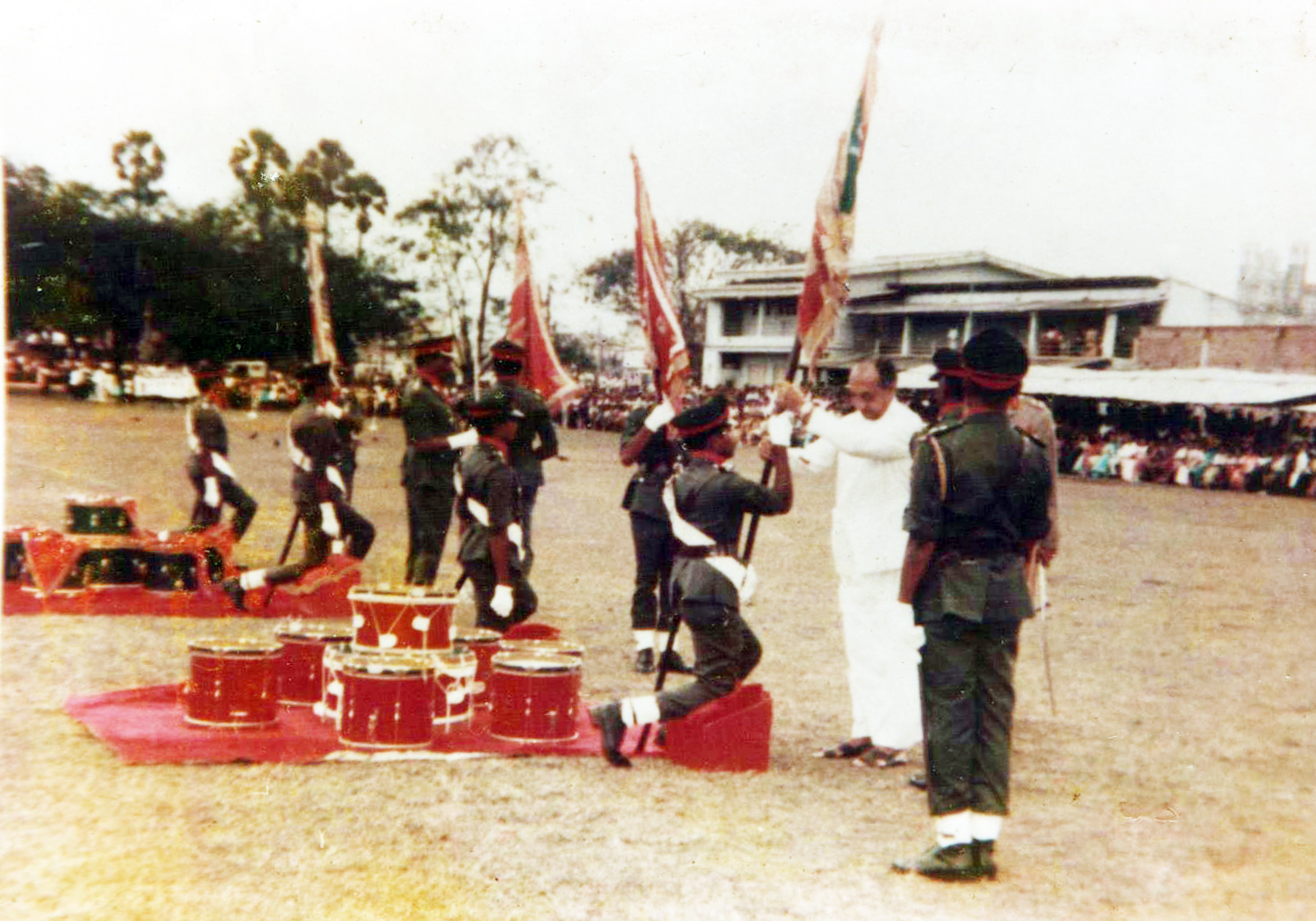
In recognition of their loyal, unstinted and sustained excellence in services performed for the Country since the inception of these Units, all three Battalions of the Gemunu Watch were awarded the prestigious President’s and Regimental Colours in 1980.
The first Executive President of the Democratic Socialist Republic of Sri Lanka, His Excellency Mr. J.R. Jayawardena, as per military tradition, presented the President’s and Regimental Colours to the three Battalions of the Gemunu Watch on 15th August 1980 at a ceremonial parade held at the Galle Esplanade.
This was the first time in the history of the Sri Lanka Army that Colours were presented by the Head of State to all Units of a Regiment.
The Commanding Officer of the 1st Battalion was Lieut. Colonel P. Pakshaweera, the (2nd) second Volunteer Battalion of the Gemunu Watch was commanded by Lieut. Colonel L.D.R. Sugathadasa and the (3rd) third Volunteer Battalion was commanded by Lieut. Colonel B.A. Perera. These Officers are greatly honoured and will be remembered for their services rendered towards the award of these Colours.
With the commencement of the war waged by the Tamil Militants in 1983, there came about a rapid expansion of the Army. Consequently, on the 27th of December 1985 the 4th Battalion of the Gemunu Watch was inaugurated under the Command of Lieut. Colonel C. L. Algama.
To date, 27 years since its inception 19 Officers have commanded 4 GW. 14 Officers and 264 Other Ranks have laid down their lives to safeguard the Unity, Sovereignty and Territorial Integrity of the Nation.
11 Officers and 181 Other Ranks Wounded-in-Action. Some partially or permanently disabled.
The 5th Battalion of the Gemunu Watch [Regulars] under the command of Lieut. Colonel G.W.W. Perera was formed in 1987. They have the distinction of being the first unit to be formed in the battle field
To date, 25 years since its inception 18 Officers have commanded 5 GW 29 Officers and 576 Other Ranks have sacrificed their lives in combat operations. 18 Officers and 450 of the Other Rank Cadre have been Wounded-ln-Action, permanently or partially. It can be gleaned from records that this Unit suffered the largest number of Officer casualties in the war against Tamil Militancy.
THE HISTORY OF THE REGIMENTAL CENTRE
In 1989, with the restructuring of the Army the concept of Brigades and Divisions emerged. Regimental Centres were formed for a more cohesive system of administration, deployment of combat resources and for the strict maintenance of discipline. Consequently, the Regimental Centre of the Gemunu Watch was established in Diyatalawa on 19th March 1989 to administer to all Regular and Volunteer Battalions of the Gemunu Watch. Currently, the Regimental Centre functions from the Paradise Camp in Kuruwita. General, then Brigadier G.H. de Silva was the first Regimental Commander [Colonel of the Regiment].
To date, 11 Regimental Commanders [Colonels of the Regiment] have held the appointment as Commanders of the Gemunu Watch Regiment.
After the activation of the Regimental Centre concept, the 6th Battalion of the Gemunu Watch was formed on 22nd May 1990 at the Imperial Camp in Diyatalawa. Major M.M. Sumanasena (was appointed) (goes down in history as) the first Commanding Officer of this Battalion.
To date, 22 years since its inception 14 Officers have commanded 6 GW.
24 Officers and 677 Other Ranks have laid down their lives in combat. 11 Officers and 510 Other Ranks have been Wounded-in-Action.
The total number of casualties exceeds that of all other Battalions that engaged in battle with the Tamil Terrorists.
The 7th Battalion of the Gemunu Watch was inaugurated on 17th September 1992 under the command of Major K.S. Fernando.
To date, 20 years since its inception 12 Officers have commanded this Unit.
On the 13th of June 2000, this Unit was amalgamated with 5 GW and on 17th May 2005 the Battalion was re-designated as the 7th Battalion once again. 07 Officers and 186 Other Ranks have sacrificed their lives in combat. 03 Officers and 210 Other Ranks have been partially or permanently disabled.
The 8th Battalion of the Gemunu Watch was established on the 28th of January 1993 under the command of Major A. Lankadeva.
For 19 years, since its inception 10 Commanding Officers have commanded this Unit. 8 GW was amalgamated with the 6 GW on 9th June 2000 and on 17th May 2005, 8 GW recommenced working as an independent Unit once again. 11 Officers and 158 Other Ranks of 8 GW have died in combat. 06 Officers and 180 Other Ranks have been Wounded-in-Action.
9 GW was formed on 24th January 1994. The first Commanding Officer was Major R.N. Akmeemana. For 18 years since its inception 09 Officers have commanded 9 GW.
On 18th June 2000, 9 GW was amalgamated with 1 GW and on 24th January 2002 it re-commenced functioning independently once again. 15 Officers and 441 Other Ranks have sacrificed their lives for their Motherland. 17 Officers and 317 Other Ranks have been Wounded-in-Action, some are permanently disabled.
The first Volunteer Battalion to serve under the Regimental Command concept was the 10th Volunteer Battalion of the Gemunu Watch which was raised on 1st June 1994. Major P.V.C.C. Waidyaratne was the first Commanding Officer of 10 [V] GW. A total of 14 Officers have commanded this Unit. Records indicate that this Unit suffered the largest casualty compared to that of any other Volunteer Battalion. 07 Officers and 188 Other Ranks have been Killed-in-Action. 11 Officers and 163 Other Ranks have been Wounded-in-Action.
The 11th Battalion of the Gemunu Watch under the command of Major W. Wimaladasa was commissioned on 04th September 1996 as an Infantry Battalion of the Regular Force. During the 16 years of its existence 04 Officers have commanded this Unit. On 17th. May 2005, 11 GW was re-named as 7 GW. During the Humanitarian Operation this Unit once more became 11 GW on 04th. October 2007. 05 Officers and 102 Other Ranks have Died-in-Action, whilst 02 Officers and 219 Other Ranks have been Wounded-in-Action.
The 12th Battalion of the Gemunu Watch was formed on 1st January 1997. Major W.B.L. Fernando was the Unit’s first Commanding Officer.
12 GW was amalgamated with 4 GW on 12th. June 2000, but became an independent Unit once again on 11th November 2002.
03 Officers have commanded this unit. 03 Officers and 130 Other Ranks have laid down their lives. 07 Officers and 279 Other Ranks have been Wounded-in-Action, some are permanently disabled.
The 14th [Volunteer] Battalion of the Gemunu Watch is the 4th. Volunteer Battalion of the Regiment and was inaugurated on 07th. January 1997. The first Commanding Officer was Major. M. Subasena.
15 years since its inception 04 Officer have commanded this unit. 09 Other Ranks have been Killed-in-Action. 20 Other Ranks have been Wounded-in-Action, some permanently.
Tamil Militants indulged in sustained belligerency since 1997. Consequently, the casualty rate reached its peak. The welfare of the Families of gallant troops Killed-in-Action and Wounded-in-Action took precedence. Army Headquarters conceived the idea of forming Reinforcement [RFT] Battalions in every Regiment to cater to the welfare requirements of the Families of these unfortunate soldiers.
Accordingly, the RFT Battalion of the Gemunu Watch was established on 17th. January 1998. The RFT Battalion was placed under command of Major W.A.A. Wanniarachchi. Since its inception, 06 Officers have commanded this Unit.
On 8th October 1999, the RFT Battalion was re-named the Headquarter Battalion. Tremendous welfare facilities have been inaugurated by this Battalion. It has also initiated various projects for the permanently and partially disabled soldiers.
The 15th Volunteer Battalion of the Gemunu Watch was established on 1st December 2007. Major. U.T. Subasinghe was its first Commanding Officer. During the Humanitarian Operation liberated areas were administered by this Unit.
03 Officers have commanded this unit. 04 Other Ranks have been Killed-in-Action. 11 Other Ranks have been Wounded-in-Action, some permanently.
16 [V] GW was formed on 9th May 2008. Major. S. Kahawewithana was the first Commanding Officer of this Unit. 03 Officers have commanded this unit.01 Other Rank has Died-in-Action. 01 Officer and 02 Other Ranks have been Wounded-in-Action.
During the Humanitarian Operation there was a need to consolidate areas liberated in holding operations so as to relieve fighting troops for front line duty. It was decided to deploy personnel who were medically categorized [of low category] with their consent. For this purpose a Unit called the 1st Reinforcement [RFT] Battalion was formed under command of Major E.A.D.P. Edirisinghe on 25th September 2008. Subsequently, the low categorized personnel were transferred to the Headquarter Battalion. Fresh troops were released to form the 25th Battalion of the Gemunu Watch which, was established on 25th September 2010. Two Officers have commanded this Unit to date.
As the final battle against the Tamil Militants progressed, more troop strengths were required to hold areas captured for the Humanitarian Operations to succeed. On 16th October 2008, the 17th Battalion of the Gemunu Watch was inaugurated. The Unit was commanded by Lieut. Colonel K.H.K.Kottawatta. 02 Officers have commanded the Unit. 01 Officer and 31 Other Ranks have sacrificed their lives for the Nation. 268 Other Ranks have been Wounded-in-Action, some have been permanently disabled.
The 18th Battalion of the Gemunu Watch, a Regular Force Battalion, was formed on 1st December 2008, commanded by Lieut. Colonel M.A.R.B. Fernando. 02 Officers have commanded the Units since its inauguration as an Infantry Battalion of the Army. During the Humanitarian Operation 02 Officers and 31 Other Ranks have made the supreme sacrifice, 05 Officers and 85 Other Ranks have been wounded, some permanently.
19 GW was inaugurated on 12th January 2009, towards the latter half of the Humanitarian Operation. The Unit was commanded by Lieut. Colonel J.M.C. Jayaweera. 03 Officers have commanded the Unit. 01 Officer and 31 Other Ranks have been Killed-in-Action. 03 Officers and 76 Other Ranks have been disabled, some of them permanently.
The 2nd Reinforcement Battalion of the Gemunu Watch was inaugurated on 31st January 2009. Major T.C.L. Ganepola was the appointed the first Commanding Officer. When additional troop strengths was provided to this Unit, the Unit was re-named 26 GW with effect from 20th September 2010. However, with the downsizing of the Army, this Battalion was disbanded on 25th April 2012 and troop strengths were distributed amongst other Battalions.
The 20th Volunteer Battalion of the Gemunu Watch was inaugurated on 7th March 2009. Major D.K. Madanayaka was appointed as the Commanding Officer. During combat operations 03 Other Ranks were Wounded-in-Action.
3 RFT Battalion of the Gemunu Watch was inaugurated on 16th April 2009. Major S. Kasthurimudali was appointed its first Commanding Officer. With additional numbers boosting its troop strength the Unit was re-designated as 27 GW on 20th September 2010. However, with the restructuring of the Army, this Unit was disbanded on 25th February 2012 and troops were attached to other Units.
The 21st Volunteer Battalion of the Gemunu Watch was inaugurated on 1st May 2009. Major M.A.S.P. Gunasena was appointed its first Commanding Officer. 02 senior Officers have commanded this Unit. 04 Other Ranks have been Killed-in-Action. 06 Other Ranks have been Wounded-in-Action.
The 22nd Volunteer Battalion of the Gemunu Watch was inaugurated on 29th July 2009. Major N.U. Wedaarachchi was appointed its first Commanding Officer. The main task of this unit was to hold and dominate the liberated areas during the Humanitarian Operations. However, with the downsizing of the Army this Unit was disbanded and troops were sent to boost up numbers in other Volunteer Battalions.
The 23rd Battalion of the Gemunu Watch was established on 15th October 2009. Lieut. Colonel. M.A.R. Hamidon was appointed as the Unit’s first Commanding Officer. The Unit was deployed in the liberated areas during the Humanitarian Operations. Since its inception 02 Senior Officers have commanded the Unit. 02 Other Ranks were Wounded-in-Action.
24 GW was inaugurated on 09th November 2009. Lieut. Colonel. W.B.J.K. Wimalaratne was appointed as its first Commanding Officer. This Unit is currently deployed in the liberated areas of the Wanni.
The Regiment of the Gemunu Watch comprises of 15 Regular Battalions, 08 Volunteer Battalions and a Headquarter Battalion with a troop strength of 17,000.
OPERATIONS
The first major operation that was conducted by the Army which involved an unprecedented deployment of 3 Brigades, was code named, “Op Liberation” or popularly known as the Vadamarachchi Operation to liberate the People of the Jaffna Peninsula from the clutches of Terrorism in 1987. It became a landmark Operation for the Gemunu Watch.
Two fighting Brigades were engaged in the Operation and one of the two Battalions in the northern thrust commanded by then Colonel Vijaya Wimalarathe [Ex- I GW] included the 1st Battalion of the Gemunu Watch commanded by Lieut. Colonel V.S. Boteju. 1 GW excelled in combat and brought about a quick end to the Operation. 2 Brigade was commanded by Brigadier G.H. de Silva [ex-1GW, who was also designated as the Overall Operations Commander] which was tasked on Deception Planning and Holding Operations. Number 3 Brigade tasked to conduct the southern thrust was commanded by the then Brigadier Denzil Kobbekaduwa.
Heroic troops of the Gemunu Watch were actively engaged in subsequent operations that were conducted in the Northern and Eastern theatres of War such as in, “Sath Bala”, “Balavegaya”, “Thrivida Balaya”, “Akunupahara”, “Rivirasa”, “Edibalaya” and “Jayasikuru”.
With the commencement of Eelam War II, 1 GW troops were engaged in holding and securing the Kiran Camp in Batticaloa. The LTTE laid siege for several days until they were finally driven back by reinforcements. Isolated troops in Kiran fought back bravely despite several onslaughts of the enemy to dislodge them. Troops were without food. Water had to be rationed. “Mustard Gas” was used by the Terrorists for the first time in war against the SLSF. The will to survive defeating enemy machinations, dominated. 1GW added a new chapter to the history of the Sri Lanka Army. 1GW was commanded by Major. Hiran Halangode who motivated troops to hold fast and inculcated in them the spirit of “never say die”. It is of special significance and must be mentioned with due pride, that Hiran Halangode is the son of the Founding Father of the Gemunu Watch, Brigadier, John. F. Halangode.
The noble warriors of the Gemunu Watch always engaged the enemy with courage and bravery during combat operations conducted to rid the Country of the terrorist menace, fighting relentlessly with scant care for life or limb. Commencing with the Humanitarian Operation conducted in Mavil –Aru they did not tarry until they reached the final destination that caused the complete rout of the Tamil Terrorists in the Nandikadal Lagoon area in Mullaitivu. During the campaign Volunteer Battalions of the Gemunu Watch were mainly engaged in holding operations and dominating areas liberated.
The competent leadership and guidance of the Senior Officers of the Gemunu Watch enabled troops at various levels in the chain of command, to maintain the relentless pursuit of aggressive action to defeat the Enemy, true to the ideals of its Motto, “Tarry Not Forward”.
The Gemunu Watch contributed with 01 General-Officer-Commanding, 01 Task Force Commander, 02 Deputy GOC’s and 14 Brigade Commanders in the campaigns against the LTTE. A total of 138 Officers and 3031 Other Ranks of the Gemunu Watch sacrificed their lives in combat. 12 Officers and 393 Other Ranks have been reported Missing-in-Action, 63 Officers and 1438 Other Ranks were Wounded-in-Action, some are permanently disabled and 31 Officers and 2534 Other Ranks reported back to their Units after medical treatment.
THE SPORTS ARENA
Heroes of the Gemunu Watch who fought for nigh on three decades to rid the Motherland of ruthless Terrorism, have excelled in the local and international sports arenas with the same zeal and commitment.
Mention must be made of Deshabandu Colonel W. Wimaladasa who won a Gold Medal in the 400 metres event at the Asian Games held in Teheran on 15th September 1974 with an Asian Games record time and later secured a second Gold Medal when he anchored the 4 X 400 Metres Relay Team to victory, establishing another Games record.
Lieut. Colonel E.A.G. Jayasiri won a Gold Medal at the Defence Services Athletics Meet in 1975 creating a new record for the event.
Brigadier J.G. Balthazar was an outstanding Athlete who graced the Athletic fields with his impressive personality. Participating in the Putt Shot, Discus Throw and Javelin field events he was for many years Army, Defence Services and National Champion.
Sgt. Mendis P.P.K. has been the National Champion in the 800 m event from 2007 to 2011. He won a Bronze Medal in the Asian Games of 2008, he has also been the Champion in the 800m in 2009 and 2011 in the Open Athletics Games held in Thailand and placed second in the 400m and 1500m events.
Sgt. Somapala S. won the Weight Lifting Championship in the 75-80 Kg category at the National Championships in 2004 & 2010.
The Gemunu Watch team won the Army Soccer Championship in 2011 and the Army Rugby Football [B] Division Championship in 2012.
The Gemunu Watch team excelled at the Novices Gymnastics Championships and won the championship title in 2011.
A war hero, Cpl. Gamini D.M. won the Asian Wheel Chair Championship Singles event in 2010.
Sgt. Perera H.A.D. L.A.M. another war hero, is a star of the of the Regiment having participated in many national and international competitions held in Thailand, Malaysia and Korea in Soccer.
Brigadier T.D. Rajapakse was an outstanding Cricketer who Captained the Army and Defence Services Cricket Teams and was selected to the National Cricket Pool.
General G.H. de Silva was a member of the National Pool in Water-Polo having represented the Defence Services in the Sport.
The outstanding performances of Captain H.K.I. Perera in the 30 m and 100m Archery events enabled the Army to secure the National Championships in 2011. Sgt.
It is noted with great pride that the Gemunu Watch has won the Army Combat Firing Championships since 2002 to date.
THE LEADERSHIP
Colonels of the Regiment are fondly remembered for the dynamic leadership they inculcated into the Rank and File of the Gemunu Watch. The excellent standards maintained are quite evident.
It is with heartfelt gratitude that we recollect the achievements of the Late Lieut. General Parami Kulatunge, a former Colonel of the Regiment, who was killed by an LTTE suicide bomber.
The current Colonel of the Regiment, Major General Major General LBR Mark RSP USP ndu, has initiated many welfare development schemes through the Regimental Centre for the Families of our war heroes Killed-in-Action and Wounded-in-Action including those who have been permanently disabled.
RE-AWARD OF COLOURS
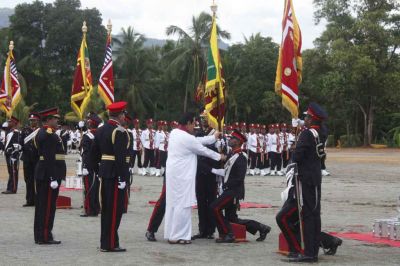
The 1st. Regular Battalion, 2nd. Volunteer and 3rd. Volunteer Battalions of The Gemunu Watch were re-awarded with the President’s and Regimental Colours after a lapse of 32 years on 15 August 2012 at an impressive and colourful parade in Kuruwita by His Excellency Mr. Mahinda Rajapakse, for sustained, loyal and distinguished service to the Nation and the Army.
Customarily, Colours are Re-Awarded after 25 years. The Operational Commitment delayed the inevitable. It must also be noted that the Award of Colours coincides with the Golden Jubilee of the formation of the 1st Battalion of the Gemunu Watch.
A significant event in the history of the Gemunu Watch must be mentioned. The Parade Commander of the Colours Re-Awarding ceremony, Brigadier J.C.P. Pakshaweera, is the eldest son of Colonel P. Pakshaweera, who commanded the Parade at the Awarding of Colours to the three Battalions of the Gemunu Watch in 1980.
The unique and proud history of the Gemunu Watch spans 50 years. They have exhibited unmatched prowess in combat, national sports events, combat firing and parade ceremonials.
It must be noted that at the last Victory Parade held on 19th May 2012, which was presided by His Excellency the President of Sri Lanka, of the 15 Services Personnel nominated to receive the highest gallantry award posthumously, the Parama Weera Vibhushana, four personnel had served in the Gemunu Watch. Much more than any other single entity can boast of.
The Gemunu Watch a prestigious and excellent Infantry Regiment, has produced two Commanders of the Army, four Chiefs-of-Staff, two Deputy Chiefs-of-Staff and 13 Major Generals.
It is stated here with great pride that the Gemunu Watch silently but majestically marches forward into the future to discharge their duties, tasks and responsibilities to the Nation and the Army selflessly and in a disciplined manner. In proper military conduct, motivated by the Spirit infused into our very being by the Motto, "Tarry Not Forward".
